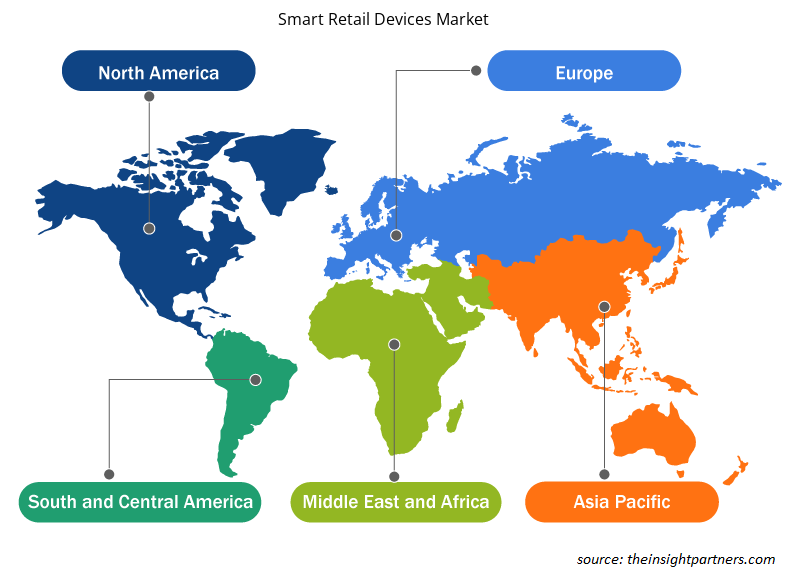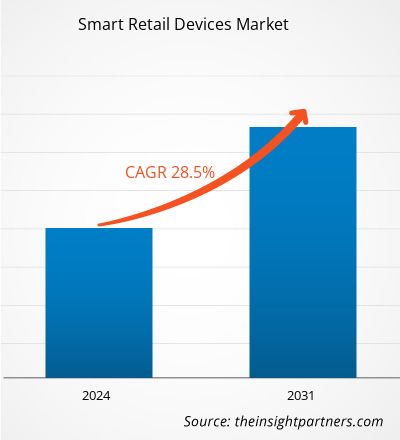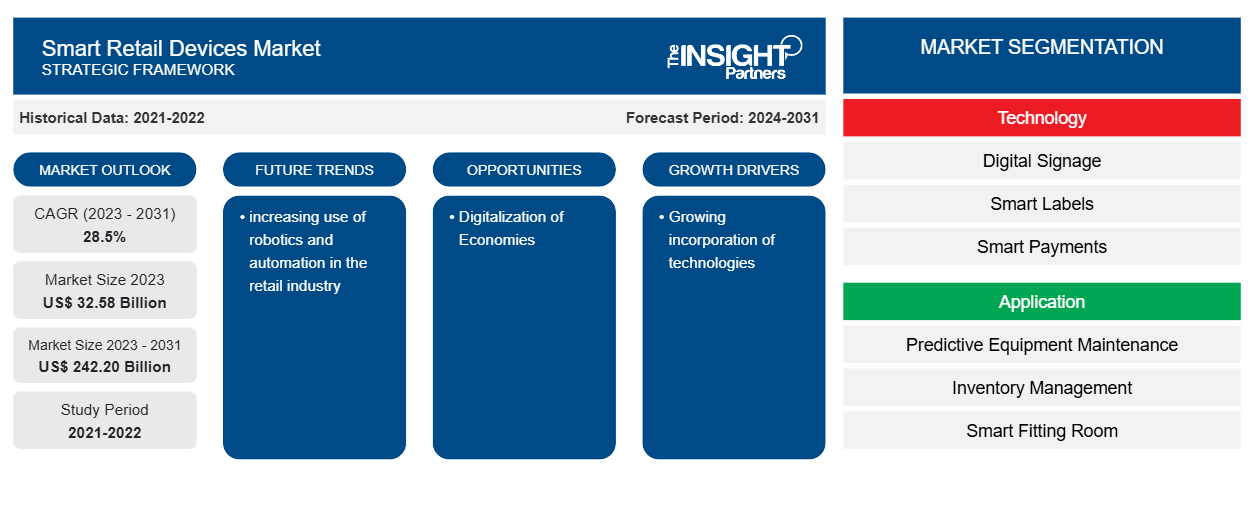La taille du marché des appareils de vente au détail intelligents devrait passer de 32,58 milliards de dollars américains en 2023 à 242,20 milliards de dollars américains d'ici 2031 ; elle devrait croître à un TCAC de 28,5 % de 2024 à 2031. L'utilisation croissante de la robotique et de l'automatisation dans le secteur de la vente au détail devrait rester l'une des principales tendances du marché des appareils de vente au détail intelligents.CAGR of 28.5% from 2024 to 2031. The increasing use of robotics and automation in the retail industry is likely to remain a key smart retail devices market trends.
Analyse du marché des appareils de vente au détail intelligents
L’adoption croissante de l’analyse des mégadonnées et de l’Internet des objets (IoT) dans le secteur de la vente au détail, ainsi que l’augmentation du pouvoir d’achat des consommateurs, sont des facteurs déterminants pour le marché des appareils de vente au détail intelligents.IoT) in the retail industry along with the surge in purchasing power of consumers are major driving factors for the smart retail devices market.
Aperçu du marché des appareils de vente au détail intelligents
Le commerce de détail intelligent consiste à utiliser la technologie et les données pour améliorer l'expérience d'achat des clients et les opérations des entreprises. Ces technologies permettent aux organisations d'améliorer l'expérience client, de rationaliser les procédures et d'obtenir des informations importantes sur le comportement des consommateurs. Ces gadgets connectés à Internet permettent aux utilisateurs d'accéder facilement à des informations et des services personnalisés, tandis que des fonctionnalités sophistiquées telles que la reconnaissance vocale et l'intégration du pavé tactile facilitent les achats, avec des assistants virtuels guidant les consommateurs à sélectionner les bons produits , à parcourir des offres intéressantes, à effectuer des achats et même à capturer et partager des expériences sur les réseaux sociaux.touchpad integration make shopping a breeze, with virtual assistants leading consumers to select the right
Personnalisez ce rapport en fonction de vos besoins
Vous bénéficierez d'une personnalisation gratuite de n'importe quel rapport, y compris de certaines parties de ce rapport, d'une analyse au niveau des pays, d'un pack de données Excel, ainsi que de superbes offres et réductions pour les start-ups et les universités.
-
Obtenez les principales tendances clés du marché de ce rapport.Cet échantillon GRATUIT comprendra une analyse de données, allant des tendances du marché aux estimations et prévisions.
Moteurs et opportunités du marché des appareils de vente au détail intelligents
Incorporation croissante des technologies pour favoriser le marché
L’intégration de technologies telles que l’intelligence artificielle (IA), la réalité virtuelle (RV), la réalité augmentée (RA) et l’Internet des objets (IoT) est de plus en plus utilisée dans le secteur de la vente au détail pour améliorer l’expérience d’achat, améliorer la gestion des stocks et rationaliser les opérations en magasin. L’Internet des objets (IoT) est un élément important de l’environnement de vente au détail intelligent, car il relie les gadgets à Internet et offre des données vitales sur le comportement des clients, les opérations en magasin et la gestion des stocks. Les appareils IoT, tels que les capteurs et les balises, permettent aux commerçants de collecter des données en temps réel sur les niveaux de stock, le flux de clients et les actifs des magasins, leur permettant ainsi de prendre des décisions plus éclairées et d’optimiser les opérations.
La numérisation des économies
L’utilisation de la numérisation offre plusieurs avantages aux magasins, notamment l’acquisition de nouveaux consommateurs et la réduction des coûts opérationnels. En outre, la numérisation a la capacité d’encourager considérablement le personnel de vente au détail. En conséquence, les détaillants peuvent voir leurs revenus augmenter. En particulier, les achats hors magasin ont connu une croissance significative en 2020. Les points de vente au détail en ligne devraient bénéficier énormément des améliorations technologiques, d’une connexion accrue, de l’introduction de nouveaux capteurs et de la disponibilité de solutions de communication transparentes , contribuant ainsi de manière significative à la croissance du marché tout au long de la période de prévision.digitalization provides several benefits to shops, including the acquisition of new consumers and the reduction of operational costs. Additionally, digitization has the ability to significantly encourage retail staff. As a result, retailers may see an increase in their revenues. Notably, non-store shopping witnessed significant growth in the year 2020. Online retail outlets are likely to benefit tremendously from technological improvements, increased connection, the introduction of novel sensors, and the availability of seamless
Analyse de segmentation du rapport sur le marché des appareils de vente au détail intelligents
Les segments clés qui ont contribué à l’élaboration de l’analyse du marché des appareils de vente au détail intelligents sont la technologie et l’application.
- En fonction de la technologie, le marché est divisé en affichage numérique, étiquettes intelligentes, paiements intelligents, chariots intelligents et autres. Le segment de l'affichage numérique détenait une part de marché plus importante en 2023.
- En termes d'application, le marché est divisé en maintenance prédictive des équipements, gestion des stocks, cabine d'essayage intelligente, surveillance du trafic piétonnier et autres. Le segment de la gestion des stocks détenait une part de marché plus importante en 2023.
Analyse des parts de marché des appareils de vente au détail intelligents par zone géographique
La portée géographique du rapport sur le marché des appareils de vente au détail intelligents est principalement divisée en cinq régions : Amérique du Nord, Asie-Pacifique, Europe, Moyen-Orient et Afrique, et Amérique du Sud/Amérique du Sud et centrale. L’Amérique du Nord a dominé le marché des appareils de vente au détail intelligents en 2023. Cette région devrait être le principal générateur de revenus du marché pendant toute la période prévue. Le désir croissant de produits haut de gamme et d’articles de luxe, associé aux changements dynamiques des préférences des clients vers des expériences de vente au détail plus pratiques et plus rapides, sont des facteurs majeurs à l’origine de cette tendance. De plus, l’intégration généralisée de la technologie numérique dans divers secteurs remodèle l’économie américaine. Les conséquences de la pandémie ont considérablement accéléré la transformation numérique des entreprises du secteur de la vente au détail, dépassant les attentes précédentes.
Aperçu régional du marché des appareils de vente au détail intelligents
Les tendances et facteurs régionaux influençant le marché des appareils de vente au détail intelligents tout au long de la période de prévision ont été expliqués en détail par les analystes d’Insight Partners. Cette section traite également des segments et de la géographie du marché des appareils de vente au détail intelligents en Amérique du Nord, en Europe, en Asie-Pacifique, au Moyen-Orient et en Afrique, ainsi qu’en Amérique du Sud et en Amérique centrale.

- Obtenez les données régionales spécifiques au marché des appareils de vente au détail intelligents
Portée du rapport sur le marché des appareils de vente au détail intelligents
| Attribut de rapport | Détails |
|---|---|
| Taille du marché en 2023 | 32,58 milliards de dollars américains |
| Taille du marché d'ici 2031 | 242,20 milliards de dollars américains |
| Taux de croissance annuel composé mondial (2023-2031) | 28,5% |
| Données historiques | 2021-2022 |
| Période de prévision | 2024-2031 |
| Segments couverts |
Par technologie
|
| Régions et pays couverts |
Amérique du Nord
|
| Leaders du marché et profils d'entreprises clés |
|
Densité des acteurs du marché : comprendre son impact sur la dynamique des entreprises
Le marché des appareils de vente au détail intelligents connaît une croissance rapide, tirée par la demande croissante des utilisateurs finaux en raison de facteurs tels que l'évolution des préférences des consommateurs, les avancées technologiques et une plus grande sensibilisation aux avantages du produit. À mesure que la demande augmente, les entreprises élargissent leurs offres, innovent pour répondre aux besoins des consommateurs et capitalisent sur les tendances émergentes, ce qui alimente davantage la croissance du marché.
La densité des acteurs du marché fait référence à la répartition des entreprises ou des sociétés opérant sur un marché ou un secteur particulier. Elle indique le nombre de concurrents (acteurs du marché) présents sur un marché donné par rapport à sa taille ou à sa valeur marchande totale.
Les principales entreprises opérant sur le marché des appareils de vente au détail intelligents sont :
- Société Intel
- Groupe Samsung
- Société NVIDIA
- LG Électronique
- Société Zebra Technologies
- Caper Inc.
Avis de non-responsabilité : les sociétés répertoriées ci-dessus ne sont pas classées dans un ordre particulier.

- Obtenez un aperçu des principaux acteurs du marché des appareils de vente au détail intelligents
Actualités et développements récents du marché des appareils de vente au détail intelligents
Le marché des appareils intelligents de vente au détail est évalué en collectant des données qualitatives et quantitatives après des recherches primaires et secondaires, qui comprennent d'importantes publications d'entreprise, des données d'association et des bases de données. Voici une liste des évolutions du marché :
- En juin 2023, Intel et Vericast ont uni leurs forces pour développer, mettre en œuvre et évaluer un réseau de médias numériques programmables de pointe pour la vente au détail en magasin. Ce système innovant s'appuie sur la technologie de ciblage avancée de Vericast et sur les puissantes plateformes logicielles Edge d'Intel pour proposer des publicités personnalisées et des détails sur les produits qui correspondent au parcours d'achat du client. Cette collaboration est un élément crucial de notre initiative plus vaste visant à révolutionner le secteur de la vente au détail et à capitaliser sur la transformation numérique des magasins physiques, qui est largement considérée comme la prochaine tendance majeure du secteur de la publicité.
(Source : Intel, communiqué de presse, 2023)
- En novembre 2023, Panasonic Connect Europe a lancé une nouvelle solution basée sur l'IA qui vise à transformer le secteur de la vente au détail en personnalisant la publicité via des assistants génératifs d'IA pour les clients pendant qu'ils font leurs achats. Cette solution innovante permet aux magasins de surveiller automatiquement les données démographiques des acheteurs et de combiner ces informations avec les préférences d'achat, les données météorologiques et les événements locaux pour personnaliser instantanément la publicité sur les écrans en magasin. Panasonic s'est associé à ADEAL Systems, un spécialiste de premier plan des données et de l'IA, pour intégrer son assistant d'achat personnel basé sur l'IA, CUSAAS (Customer Segmentation As-A-Service), à des solutions de caméra et d'affichage de pointe pour la vente au détail, créant ainsi une expérience d'achat améliorée.
(Source : Panasonic, communiqué de presse, 2023)
Rapport sur le marché des appareils de vente au détail intelligents : couverture et livrables
Le rapport « Taille et prévisions du marché des appareils de vente au détail intelligents (2021-2031) » fournit une analyse détaillée du marché couvrant les domaines ci-dessous :
- Taille du marché et prévisions aux niveaux mondial, régional et national pour tous les segments de marché clés couverts par le périmètre
- Dynamique du marché, comme les facteurs moteurs, les contraintes et les opportunités clés
- Principales tendances futures
- Analyse détaillée des cinq forces de PEST/Porter et SWOT
- Analyse du marché mondial et régional couvrant les principales tendances du marché, les principaux acteurs, les réglementations et les développements récents du marché
- Analyse du paysage industriel et de la concurrence couvrant la concentration du marché, l'analyse de la carte thermique, les principaux acteurs et les développements récents
- Profils d'entreprise détaillés
- Analyse historique (2 ans), année de base, prévision (7 ans) avec TCAC
- Analyse PEST et SWOT
- Taille du marché Valeur / Volume - Mondial, Régional, Pays
- Industrie et paysage concurrentiel
- Ensemble de données Excel
Rapports récents
Témoignages
Raison d'acheter
- Prise de décision éclairée
- Compréhension de la dynamique du marché
- Analyse concurrentielle
- Connaissances clients
- Prévisions de marché
- Atténuation des risques
- Planification stratégique
- Justification des investissements
- Identification des marchés émergents
- Amélioration des stratégies marketing
- Amélioration de l'efficacité opérationnelle
- Alignement sur les tendances réglementaires























 Obtenez un échantillon gratuit pour - Marché des appareils intelligents de vente au détail
Obtenez un échantillon gratuit pour - Marché des appareils intelligents de vente au détail